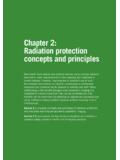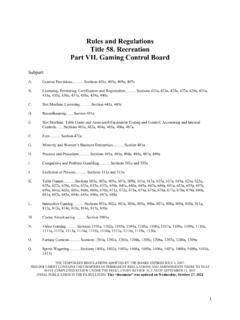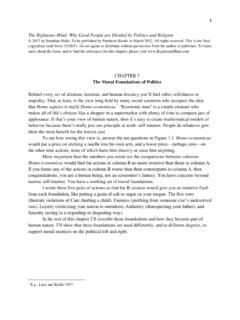Transcription of Final Chapter 2 - NCERT
1 Federalism13 Chapter 2 FederalismOverviewIn the previous Chapter , we noted that vertical division of power amongdifferent levels of government is one of the major forms of power-sharing in modern democracies. In this Chapter , we focus on this formof power-sharing. It is most commonly referred to as federalism. Webegin by describing federalism in general terms. The rest of the chaptertries to understand the theory and practice of federalism in India. Adiscussion of the federal constitutional provisions is followed by ananalysis of the policies and politics that has strengthened federalism inpractice. Towards the end of the Chapter , we turn to the localgovernment, a new and third tier of Indian 2214 Democratic PoliticsWhat is federalism?Let us get back to the contrast betweenBelgium and Sri Lanka that we saw inthe last Chapter . You would recall thatone of the key changes made in theConstitution of Belgium was to reducethe power of the Central Governmentand to give these powers to the regionalgovernments.
2 Regional governmentsexisted in Belgium even earlier. Theyhad their roles and powers. But all thesepowers were given to thesegovernments and could be withdrawnby the Central Government. Thechange that took place in 1993 was thatthe regional governments were givenconstitutional powers that were nolonger dependent on the centralgovernment. Thus, Belgium shiftedfrom a unitary to a federal form ofgovernment. Sri Lanka continues to be,for all practical purposes, a unitarysystem where the national governmenthas all the powers. Tamil leaders wantSri Lanka to become a federal is a system ofgovernment in which the power isdivided between a central authority andvarious constituent units of thecountry. Usually, a federation has twolevels of government. One is thegovernment for the entire country thatis usually responsible for a few subjectsof common national interest. Theothers are governments at the level ofprovinces or states that look aftermuch of the day-to-day administeringof their state.
3 Both these levels ofgovernments enjoy their powerindependent of the am do we callthe Indiangovernment? Isit Union, Federalor Central?Though only 25 of the world s 193 countries have federal political systems, their citizens make up 40 per cent of theworld s population. Most of the large countries of the world are federations. Can you notice an exception to this rulein this map?Source: Montreal and Kingston, Handbook of Federal Countries: 2002, McGill-Queen s University Press, systemsCanadaUnited Statesof AmericaMexicoPACIFIC OCEANM icronesiaArgentinaVenezuelaATLANTICOCEAN B razilSt. Kittsand NevisBelgiumSwitzerlandSpainNigeriaEthio piaComorosBosnia andHerzegovinaAustriaPakistanRussiaIndia MalaysiaAustraliaINDIANOCEANS outh AfricaPACIFIC OCEANU nitedArabEmiratesGermany2021 22 Federalism15 Jurisdiction: T he areaov er which someonehas legal authority. Thearea may be defined interms of geographicalboundaries or in termsof certain kinds federal system thus has dualobjectives: to safeguard and promoteunity of the country, while at the sametime accommodate regional , two aspects are crucial forthe institutions and practice offederalism.
4 Governments at differentlevels should agree to some rules ofpower-sharing. T hey should also trustthat each would abide by its part ofthe agr eement. An ideal federal systemhas both aspects : mutual trust andagreement to live exact balance of powerbetween the central and the stategovernment varies from one federationto another. This balance dependsmainly on the historical context in whichthe federation was formed. There aretwo kinds of routes through whichfederations have been formed. T he firstroute involves independent Statescoming together on their own to forma bigger unit, so that by poolingsovereignty and retaining identity theycan increase their security. This type of coming together federations includethe USA, Switzerland and Australia. Inthis first category of federations, all theconstituent States usually have equalpower and are strong vis- -vis thefederal gov second route is where a largecountry decides to divide its powerbetween the constituent States and thenational gov ernment.
5 India, Spain andBelgium are examples of this kind of holding together federations. Inthis second category, the centralgovernment tends to be more powerfulvis- -vis the States. V ery often differentconstituent units of the federation haveunequal powers. Some units aregr anted special federalismworks only in bigcountries, whydid Belgiumadopt it?In this sense, federations arecontrasted with unitary gov the unitary system, either thereis only one level of government or thesub-units are subordinate to the centralgov ernment. The central gov ernmentcan pass on orders to the provincial orthe local gov ernment. But in a federalsystem, the central gov ernment cannotorder the state government to dosomething. State government haspowers of its own for which it is notanswerab le to the central gov these gov ernments are separatelyanswerab le to the us look at some of the keyfeatures of federalism :1 There are two or more levels (ortiers) of gov tiers of governmentgo vern the same citizens, but each tierhas its own JURISDICTION in specificmatters of legislation, taxation jurisdictions of the respectivelevels or tiers of government arespecified in the constitution.
6 So theexistence and authority of each tier ofgovernment is fundamental provisions ofthe constitution cannot be unilaterallychanged by one level of gov changes require the consent ofboth the levels of have the power to interpretthe constitution and the powers ofdifferent levels of government. Thehighest court acts as an umpire ifdisputes arise between different levelsof gov ernment in the exercise of theirrespective of rev enue for each levelof gov ernment are clearly specified toensure its financial 2216 Democratic PoliticsIsn t thatstrange? Did ourconstitutionmakers not knowaboutfederalism? Ordid they wish toav oid talkingabout it?Some Nepalese citizens were discussing the proposals on the adoptionof federalism in their new constitution. This is what some of them said:Khag Raj: I don t like federalism. It would lead to reservation of seats fordifferent caste groups as in : Ours in not a very big country. We don t need Lal: I am hopeful that the Terai areas will get more autonomy if they gettheir own state Ganesh: I like federalism because it will mean that powers that were earlierenjoyed by the king will now be exercised by our elected you were participating in this conversation what would be your response to eachof these?
7 Which of these reflect a wrong understanding of what federalism is?What makes India a federal country?We have earlier seen how smallcountries like Belgium and Sri Lankaface so many problems of managingdiversity. What about a vast country likeIndia, with so many languages, religionsand regions? What are the powersharing arrangements in our country?Let us begin with the had emerged as an independentnation after a painful and bloodypartition. Soon after Independence,several princely states became a part ofthe country. The Constitution declaredIndia as a Union of States. Although itdid not use the word federation, theIndian Union is based on the principlesof us go back to the seven featuresof federalism mentioned above. We cansee that all these features apply to theprovisions of the Indian Constitution originally providedfor a two-tier system of gov ernment,the Union Government or what we callthe Central Government, representingthe Union of India and the Stategovernments.
8 Later, a third tier offederalism was added in the form ofPanchaya ts and Municipalities. As inany federation, these different tiersenjoy separate jurisdiction. TheConstitution clearly provided a three-fold distribution of legislative powersbetween the Union Government andthe State Governments. Thus, itcontains three lists:lUnion List includes subjects ofnational importance such as defenceof the country, foreign affairs, banking,communications and currency. Theyare included in this list because we needa uniform policy on these mattersthroughout the country. The UnionGovernment alone can make lawsrelating to the subjects mentioned inthe Union List contains subjects ofState and local importance such aspolice, trade, commerce, agricultureand irrigation. T he State GovernmentsWhat makes India a federal country?2021 22 Federalism17forest, trade unions, marriage,adoption and succession.
9 Both theUnion as well as the StateGovernments can make laws on thesubjects mentioned in this list. If theirlaws conflict with each other, the lawmade by the Union Governmentwill about subjects that do notfall in any of the three lists? Orsubjects like computer software thatcame up after the constitution wasmade? According to our constitution,the Union Government has the powerto legislate on these residuary noted above that mostfederations that are formed by holding together do not give equalpower to its constituent units. Thus,all States in the Indian Union do nothave identical powers. Some Statesenjoy a special status. States such asAssam, Nagaland, Arunachal Pradeshand Mizoram enjoy special powersunder certain provisions of theConstitution of India (Article 371)due to their peculiar social andhistorical circumstances. These specialpowers are especially enjoyed inrelation to the protection of landrights of indigenous peoples, theirculture and also preferentialemployment in government who are not permanentresidents of this State cannot buy landor house here.
10 Similar specialIf agriculture andcommerce arestate subjects,why do we haveministers ofagriculture andcommerce in theUnion cabinet?Listen to one national and one regional news bulletin broadcast by All India Radiodaily for one week. Make a list of news items related to government policies ordecisions by classifying these into the following categories:lNews items that relate only to the Central Government,lNews items that relate only to your or any other State Government,lNews items about the relationship between the Central and State exist for some other Statesof India as are some units of the IndianUnion which enjoy very little are areas which are too small tobecome an independent State butwhich could not be merged with anyof the existing States. These areas, likeChandigarh, or Lakshadweep or thecapital city of Delhi, are called UnionTerritories. These territories do nothave the powers of a State. TheCentral Government has specialpowers in running these sharing of power between theUnion Government and the Stategovernments is basic to the structureof the Constitution.














